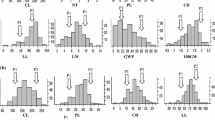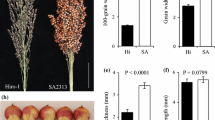Abstract
Perennial sorghum cropping offers substantial economic and ecological benefits, conserving fuel, water, and soil. To be perennial in temperate climates, a sorghum plant must over-winter and produce new growth the following spring—a trait derived from the weedy species Sorghum halepense. We have introduced perenniality from S. halepense into a S. bicolor background and identified QTL affecting eight seed yield-related traits and their linkage relationships. Interval mapping in this BC1F2 population derived from S. bicolor × S. halepense revealed a total of 80 QTL with LOD scores greater than 2.5 for the eight traits, with a range of 1 to 13 QTL per trait. Additional QTL were detected in multiple-QTL analyses. The traits mapped in this study showed diverse genetic complexity; the pattern of one major plus several minor QTL was observed for most traits, and traits varied in the number of QTL and direction of allelic effects. For four traits evaluated across locations, some QTL detected in one of the two locations had virtually no effect in the other, suggesting an environmental influence on QTL expression. The results contribute to fundamental knowledge of the genetic architecture underlying seed yield and may support development of high yielding perennial grain sorghum varieties.

Similar content being viewed by others
Availability of data and material
The datasets generated during and/or analysed during the current study are available from the corresponding author on request.
Code availability
Not applicable.
References
Arriola PE, Ellstrand NC (1996) Crop-to-weed gene flow in the genus Sorghum (Poaceae): spontaneous interspecific hybridization between johnsongrass, Sorghum halepense, and crop sorghum, S. bicolor. Am J Bot 83:1153–1159
Almeida GD, Makumbi D, Magorokosho C et al (2013) QTL mapping in three tropical maize populations reveals a set of constitutive and adaptive genomic regions for drought tolerance. Theor Appl Genet 126:583–600. https://doi.org/10.1007/s00122-012-2003-7
Bates D, Mächler M, Bolker B, Walker S (2015) Fitting linear mixed-effects models using lme4. J Statist Softw 67(1):1–48
Bauer AM, Hoti F, von Korff M et al (2009) Advanced backcross-QTL analysis in spring barley (H. vulgare ssp. spontaneum) comparing a REML versus a Bayesian model in multi-environmental field trials. Theor Appl Genet 119:105–123. https://doi.org/10.1007/s00122-009-1021-6
Beavis W (1997) QTL analyses: power, precision and accuracy. In: Paterson AH (ed) Molecular dissection of complex traits. CRC Press, New York
Bernardo R (2008) Molecular markers and selection for complex traits in plants: learning from the last 20 years. Crop Sci 48:1649–1664. https://doi.org/10.2135/cropsci2008.03.0131
Boerma HR, Walker DR (2005) Discovery and utilization of QTLs for insect resistance in soybean. Genetica 123:181–189
Broman KW, Wu H, Sen S, Churchill GA (2003) R/qtl: QTL mapping in experimental crosses. Bioinform Appl Note 19:889–890. https://doi.org/10.1093/bioinformatics/btg112
Broman KW, Sen S (2009) Guide to QTL mapping with R/qtl. Springer-Verlag, New York, NY, pp 1–396
Brown JK (2002) Yield penalties of disease resistance in crops. Curr Opin Plant Biol 5:339–344. https://doi.org/10.1016/S1369-5266(02)00270-4
Cao Z, Tian F, Wang N et al (2010) Analysis of QTLs for erucic acid and oil content in seeds on A8 chromosome and the linkage drag between the alleles for the two traits in Brassica napus. J Genet Genom 37:231–240. https://doi.org/10.1016/S1673-8527(09)60041-2
Carlborg O, Jacobsson L, Ahgren P et al (2006) Epistasis and the release of genetic variation during long-term selection. Nat Genet 38:418–420. https://doi.org/http://www.nature.com/ng/journal/v38/n4/suppinfo/ng1761_S1.html
Chen Y, Lübberstedt T (2010) Molecular basis of trait correlations. Trends Plant Sci 15:454–461. https://doi.org/10.1016/j.tplants.2010.05.004
Churchill GA, Doerge RW (1994) Empirical threshold values for quantitative trait mapping. Genetics 138:963–971
Collard BCY, Jahufer MZZ, Brouwer JB, Pang ECK (2005) An introduction to markers, quantitative trait loci (QTL) mapping and marker-assisted selection for crop improvement: the basic concepts. Euphytica 142:169–196. https://doi.org/10.1007/s10681-005-1681-5
Collard BCY, Mackill DJ (2008) Marker-assisted selection: an approach for precision plant breeding in the twenty-first century. Philos Trans R Soc B Biol Sci 363:557–572
Collins A, Milbourne D, Ramsay L et al (1999) QTL for field resistance to late blight in potato are strongly correlated with maturity and vigour. Mol Breed 5:387–398. https://doi.org/10.1023/A:1009601427062
Cordell HJ (2009) Detecting gene–gene interactions that underlie human diseases. Nat Rev Genet 10:392–404
Cox S, Bender M, Picone C et al (2002) Breeding perennial grain crops. CRC Crit Rev Plant Sci 21:59–91
Cox S, Glover JD, Van Tassel DL et al (2006) Prospects for developing perennial grain crops. Bioscience 56:649–659. https://doi.org/10.1641/0006-3568(2006)56[649:pfdpgc]2.0.co;2
Cox TS, Nabukalu P, Paterson AH et al (2018) Development of perennial grain sorghum. Sustain 10:. https://doi.org/10.3390/su10010172
DeHaan LR, Van Tassel DL, Cox TS (2005) Perennial grain crops: a synthesis of ecology and plant breeding. Renew Agric Food Syst 20:5–14. https://doi.org/10.1079/RAF200496
Dinnes DL, Karlen DL, Jaynes DB et al (2002) Nitrogen management strategies to reduce nitrate leaching in tile-drained Midwestern soils. Agron J 94:153–171
Entz MH, Baron VS, Carr PM et al (2002) Potential of forages to diversify cropping systems in the Northern Great Plains. Agron J 94:240–250
Falconer DS, Douglas S (1989) Introduction to quantitative genetics, 3rd ed. Longman, Scientific & Technical, Burnt Mill
Frary A, Fulton TM, Zamir D, Tanksley SD (2004) Advanced backcross QTL analysis of a Lycopersicon esculentum × L. pennellii cross and identification of possible orthologs in the Solanaceae. Theor Appl Genet 108:485–496. https://doi.org/10.1007/s00122-003-1422-x
Gantzer CJ, Anderson SH, Thompson AL, Brown JR (1990) Estimating soil erosion after 100 years of cropping on Sanborn Field. J Soil Water Conserv 45(6):641–644
Glaubitz JC, Casstevens TM, Lu F et al (2014) TASSEL-GBS: a high capacity genotyping by sequencing analysis pipelineTASSEL-GBS: a high capacity genotyping by sequencing analysis pipeline. PLoS One 9:e90346. https://doi.org/10.1371/journal.pone.0090346
Glover JD, Reganold JP, Bell LW et al (2010) Increased food and ecosystem security via perennial grains. Science 328:1638–1639
Habyarimana E, Lorenzoni C, Redaelli R et al (2018) Towards a perennial biomass sorghum crop: a comparative investigation of biomass yields and overwintering of Sorghum bicolor × S. halepense lines relative to long term S. bicolor trials in northern Italy. Biomass Bioenerg 111:187–195. https://doi.org/10.1016/j.biombioe.2017.03.004
Hadley HH (1958) Chromosome numbers, fertility and rhizome expression of hybrids between grain Sorghum and Johnsongrass1. Agron J 50:278. https://doi.org/10.2134/agronj1958.00021962005000050015x
Haggard JE, Johnson EB, St. Clair DA (2013) Linkage relationships among multiple QTL for horticultural traits and late blight (P. infestans) resistance on chromosome 5 introgressed from wild tomato Solanum habrochaites. G3 Genes, Genomes, Genet 3:2131–2146. https://doi.org/10.1534/g3.113.007195
Haley CS, Knott SA (1992) A simple regression method for mapping quantitative trait loci in line crosses using flanking markers. Heredity 69:315–324
Holm LRG (1991) The world’s worst weeds: distribution and biology. Krieger Publishing Company, Malabar
ICRISAT (1993) Descriptors for Sorghum: Sorghum bicolor (L.) Moench = Descripteurs du sorgho: Sorghum bicolor (L.) Moench. IBPGR/ICRISAT
Kong W, Nabukalu P, Cox TS et al (2020) Transmission Genetics of a Sorghum bicolor × S. halepense Backcross Populations. Front Plant Sci 11:467. https://doi.org/10.3389/fpls.2020.00467
Lenth RM (2016) Least-squares means: The R package lsmeans. J Statist Softw 69:1–33
Lewis RS, Rose C (2010) Agronomic performance of tobacco mosaic virus-resistant tobacco lines and hybrids possessing the resistance gene N introgressed on different chromosomes. Crop Sci 50:1339–1347. https://doi.org/10.2135/cropsci2009.10.0615
MacKay TFC, Stone EA, Ayroles JF (2009) The genetics of quantitative traits: challenges and prospects. Nat Rev Genet 10:565–577
Manichaikul A, Moon JY, Sen Ś et al (2009) A model selection approach for the identification of quantitative trait loci in experimental crosses, allowing epistasis. Genetics 181:1077–1086. https://doi.org/10.1534/genetics.108.094565
McWhorter CG (1961) Morphology and development of johnsongrass plants from seeds and rhizomes. Weeds 558–562
Miklas PN (2007) Marker-assisted backcrossing QTL for partial resistance to sclerotinia white mold in dry beanMarker-assisted backcrossing QTL for partial resistance to sclerotinia white mold in dry bean. Crop Sci 47:935–942. https://doi.org/10.2135/cropsci2006.08.0525
Nabukalu P, Cox TS (2016) Response to selection in the initial stages of a perennial sorghum breeding program. Euphytica. https://doi.org/10.1007/s10681-016-1639-9
Newbury HJ (2003) Plant molecular breeding. Blackwell, Oxford
Paterson A, Damon S, Hewitt JD et al (1991) Mendelian factors underlying quantitative traits in tomato: comparison across species, generations, and environments. Genetics 127(1):181–197
Paterson A, Schertz KF, Lin YR et al (1995) The weediness of wild plants: molecular analysis of genes influencing dispersal and persistence of johnsongrass, Sorghum halepense (L.) Pers. Proc Natl Acad Sci USA 92:6127–6131. https://doi.org/10.1073/pnas.92.13.6127
Paterson AH, Bowers JE, Bruggmann R et al (2009) The Sorghum bicolor genome and the diversification of grasses. Nature 457:551–556. https://doi.org/10.1038/nature07723
Pimentel D, Allen J, Beers A et al (1987) World agriculture and soil erosion. Bioscience 37:277–283
Ping LI, LiKhuang ZHU, YingKguo ZHU (2003) Characterization of QTLs for harvest index and source-sink characters in a DH population of rice (Oryza sativa L.). Acta Genet Sin 30(12):1118–1126
Piper JK, Kulakow PA (1994) Seed yield and biomass allocation in Sorghum bicolor and F 1 and backcross generations of S. bicolor × S. halepense hybrids. Can J Bot 72:468–474. https://doi.org/10.1139/b94-062
Randall GW, Mulla DJ (2001) Nitrate nitrogen in surface waters as influenced by climatic conditions and agricultural practices. J Environ Qual 30:337–344. https://doi.org/10.2134/jeq2001.302337x
Ritter KB, Jordan DR, Chapman SC et al (2008) Identification of QTL for sugar-related traits in a sweet × grain sorghum (Sorghum bicolor L. Moench) recombinant inbred population. Mol Breed 22:367–384. https://doi.org/10.1007/s11032-008-9182-6
Rooney W (2004) Sorghum improvement–integrating traditional and new technology to produce improved genotypes. Adv Agron 83:37–109
Schertz KF, Clark LE (1967) Controlling dehiscence with plastic bags for hand crosses in Sorghum 1. Crop Sci 7:540–542. https://doi.org/10.2135/cropsci1967.0011183x000700050040x
Singh BD, Singh AK (2015) Marker-assisted plant breeding: principles and practices. Springer, New Delhi
Tanksley SD, McCouch SR (1997) Seed banks and molecular maps: unlocking genetic potential from the wild. Science 277:1063–1066. https://doi.org/10.1126/science.277.5329.1063
Taylor MB, Ehrenreich IM (2015) Higher-order genetic interactions and their contribution to complex traits. Trends Genet 31:34–40. https://doi.org/10.1016/j.tig.2014.09.001
Voorrips RE (2002) MapChart: software for the graphical presentation of linkage maps and QTLs. J Hered 93:77–78. https://doi.org/10.1093/jhered/93.1.77
Wagoner P (1990) Perennial grain development: past efforts and potential for the future. CRC Crit Rev Plant Sci 9:381–408. https://doi.org/10.1080/07352689009382298
Weller JI (1986) Maximum likelihood techniques for the mapping and analysis of quantitative trait loci with the aid of genetic markers. Biometrics 42:627–640
Xiao J, Li J, Grandillo S et al (1998) Identification of trait-improving quantitative trait loci alleles from a wild rice relative, Oryza rufipogon. Genetics 150:899
Xu Y (2010) Molecular plant breeding. CABI, Wallingford
Xu Y, Crouch JH (2008) Marker-assisted selection in plant breeding: from publications to practice. Crop Sci 48:391–407
Xu S (2003) Theoretical basis of the beavis effect. Genetics 165(4):2259–2268
Yoon DB, Kang KH, Kim HJ et al (2006) Mapping quantitative trait loci for yield components and morphological traits in an advanced backcross population between Oryza grandiglumis and the O. sativa japonica cultivar Hwaseongbyeo. Theor Appl Genet 112:1052–1062
Zhang H, Mittal N, Leamy LJ et al (2017) Back into the wild-apply untapped genetic diversity of wild relatives for crop improvement. Evol Appl 10:5–24. https://doi.org/10.1111/eva.12434
Zhao K, Wright M, Kimball J et al (2010) Genomic diversity and introgression in O. sativa reveal the impact of domestication and breeding on the rice genome. PLoS One. https://doi.org/10.1371/journal.pone.0010780
Funding
This work was funded in whole or part by the United States Agency for International Development (USAID) Bureau for Resilience and Food Security under Agreement # AID-OAAA-13-00044 as part of Feed the Future Innovation Lab for Climate Resilient Sorghum. Any opinions, findings, conclusions, or recommendations expressed here are those of the authors alone.
Author information
Authors and Affiliations
Contributions
All authors contributed to and approved the final manuscript. SC conceived the study, generated the population, and contributed to experimental setup and phenotyping, manuscript review; PN contributed to phenotyping, data analyses, and manuscript write-up, WK contributed to phenotyping, mapping, marker identification, and data analyses; AP co-conceived the study, contributed to phenotyping, marker identification, data interpretation, and manuscript review.
Corresponding author
Ethics declarations
Conflict of interest
The authors declare that they have no conflict of interest.
Ethical approval
Not applicable.
Consent to participate
Not applicable.
Consent to publication
Not applicable.
Additional information
Publisher's Note
Springer Nature remains neutral with regard to jurisdictional claims in published maps and institutional affiliations.
Electronic supplementary material
Below is the link to the electronic supplementary material.
Rights and permissions
About this article
Cite this article
Nabukalu, P., Kong, W., Cox, T.S. et al. Detection of quantitative trait loci regulating seed yield potential in two interspecific S. bicolor2 × S. halepense subpopulations. Euphytica 217, 13 (2021). https://doi.org/10.1007/s10681-020-02734-3
Received:
Accepted:
Published:
DOI: https://doi.org/10.1007/s10681-020-02734-3




